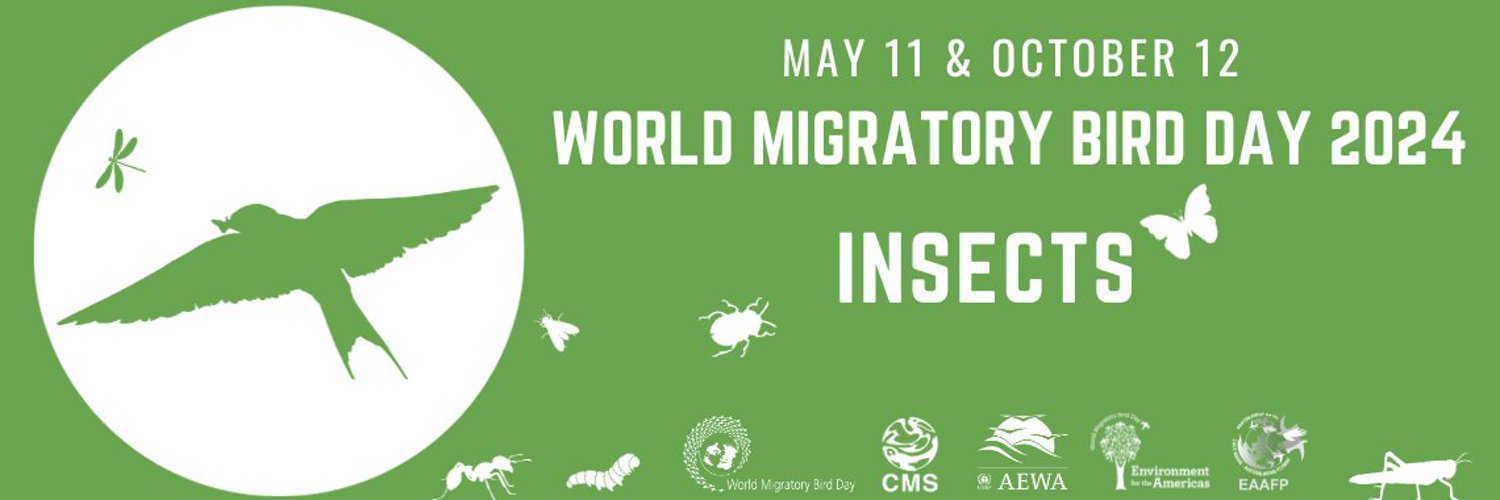World Migratory Bird Day
World Migratory Bird Day
World Migratory Bird Day is an annual awareness-raising campaign highlighting the need for the conservation of migratory birds and their habitats. It has a global outreach and is an effective tool to help raise global awareness of the threats faced by migratory birds, their ecological importance, and the need for international cooperation to conserve them.
The campaign "World Migratory Bird Day" is celebrated twice a year, on the second Saturday in May and in October, reflecting the cyclical nature of bird migration with varying migration periods in the northern and southern hemispheres.
Background
World Migratory Bird Day was initiated in 2006 by the Secretariat of the Agreement on the Conservation of African-Eurasian Migratory Waterbirds (AEWA) in collaboration with the Secretariat of the Convention on the Conservation of Migratory Species of Wild Animals (CMS).
On 26 October 2017 in the margins of the CMS COP12 in Manila, Environment for the Americas (EFTA), the Convention on Migratory Species (CMS) and the Agreement on the Conservation of African-Eurasian Migratory Waterbirds (AEWA), announced an innovative partnership to increase awareness of the plight of migratory birds around the world. The new partnership formally unites two of the world's largest bird education campaigns, International Migratory Bird Day (IMBD) and World Migratory Bird Day (WMBD) in a bid to strengthen global recognition and appreciation of migratory birds and highlight the urgent need for their conservation. Starting in 2018, the new joint campaign adopts the single name of "World Migratory Bird Day" and major events to celebrate the day will be organized twice a year, on the second Saturday in May and in October.
Migratory birds
Why migratory birds?
Avian migration is a natural miracle. Migratory birds fly hundreds and thousands of kilometres to find the best ecological conditions and habitats for feeding, breeding and raising their young. When conditions at breeding sites become unfavourable, it is time to fly to regions where conditions are better.
There are many different migration patterns. The majority of birds migrate from northern breeding areas to southern wintering grounds. However, some birds breed in southern parts of Africa and migrate to northern wintering grounds, or horizontally, to enjoy the milder coastal climates in winter. Other birds reside on lowlands during the winter months and move up a mountain for the summer.
Migratory birds have the perfect morphology and physiology to fly fast and across long distances. Often, their journey is an exhausting one, during which they go to their limits. The Red Knot has one of the longest total migration routes of any bird, travelling up to 16,000 kilometres twice a year. It breeds in Siberia and overwinters on the west coast of Africa, some even going down to the tip of South Africa.
It is truly amazing how migratory birds can navigate with pin-point accuracy. Exactly how migrating birds find their flyways is not fully understood. It has been shown that they are able to orientate by the sun during the day, by the stars at night, and by the geomagnetic field at any time. Some species can even detect polarized light, which many migrating birds may use for navigation at night.
Why Migratory Birds Need Protection
Migration is a perilous journey and involves a wide range of threats, often caused by human activities. And as diverse as people and their habits in different countries are, so are threats the birds face. As migratory birds depend on a range of sites along their distribution area, the loss of wintering and stopover sites could have a dramatic impact on the birds’ chances of survival.
Flying long distances involves crossing many borders between countries with differing environmental politics, legislation and conservation measures. It is evident that international cooperation among governments, NGOs and other stakeholders is required along the entire flyway of a species in order to share knowledge and to coordinate conservation efforts.
Theme for 2024 - Protect insects, protect birds
 In 2024, World Migratory Bird Day will be celebrated on two days, 11 May and 12 October, aligning with the cyclic nature of bird migration in different hemispheres.
In 2024, World Migratory Bird Day will be celebrated on two days, 11 May and 12 October, aligning with the cyclic nature of bird migration in different hemispheres.
The theme will focus on the importance of insects for migratory birds, and highlight concerns related to decreasing populations of insects.
Insects are essential sources of energy for many migratory bird species, not only during the breeding seasons but also during their extensive journeys and greatly affect the timing, duration, and overall success of bird migrations.
Along their migration routes, birds actively seek out insects in fields, forests, wetlands, and various habitats during stopovers. The timing of bird migration often coincides with peak insect abundance at stopover locations, supplying nourishment for birds to replenish their energy reserves before continuing their journeys.
The loss and disturbance of insect populations at breeding sites and along avian migration routes threaten bird survival and well-being. Natural spaces like forests and grasslands that have been transformed or endangered by intensive agriculture and urban development and its effects such as light pollution can result in a decline in insect populations. Pesticides and herbicides designed to protect crops harm insects that birds rely on for food. A scarcity of energy- and protein-rich insects can hinder bird migration and breeding, leading to weakened immune systems, reduced reproductive success, and increased mortality rates for both adult birds and their offspring.
Source : WMBD portal
Last Modified : 5/8/2024
This page covers basic information about trees.
This topics covers information about Amla pests.
This topic covers information about Ber Pests.
This page explains about the Colour variation in I...
